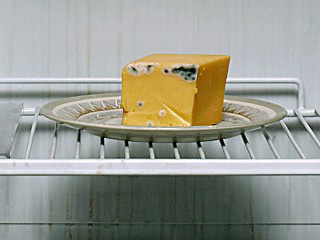When to throw food in the refrigerator
Should you throw moldy bread in the trash, or just cut off the blue mold? Is the piece of beef in the refrigerator three days safe? Such questions can become a topic of controversy among couples since the birth of the refrigerator.
Scientists are studying ways to detect the rancidity of food - such as sensors that disconnect when milk changes flavor or a polymer capable of detecting the growth of bacteria in meat. But while waiting for those devices to be marketed, food safety experts can give us some advice.

A piece of butter is moldy.Photo: ABC News.
"Food that smells unpleasant doesn't mean it will make you sick ," said Michael Doyle, director of the University of Georgia's Food Safety Center (Georgia, USA).
Michael said that in food there are bacteria that cause rancidity and pathogens, and there is a difference between them.
The rancid bacteria create thin strands of meat, vegetables and bread. But often they will outperform bacteria that are harmful in quantity and protect food.
The germs in food have no taste, color and cannot be seen. 'Even when using a microscope, you can't see them , ' Michael said.
Catherine Donnelly, nutrition professor at the University of Vermont (Vermont, USA), said that to ensure safety, you must leave food in an environment that satisfies 'number 4': no more than four days, in heat 4 degrees Celsius
'About 25% of refrigerators in the US operate at temperatures that can make food unsafe. We use refrigerators to preserve food and most don't know which temperature is reasonable, ' Catherine said.
Temperature can slow or stop bacterial growth. At 4 degrees C, you can leave chicken and beef for three days and four days for some other foods.
Leaving food in an environment with temperatures greater than 4 degrees Celsius can make the difference between illness and safety.
'In a high temperature environment, a small number of bacteria can cause terrible consequences. Therefore, you should not throw food into the car and drive around a few hours before going home. Bacteria grow with the passage of time and the rise of temperature. If you take the leftovers from the restaurant home, you have to put them in the refrigerator within two hours later, ' Catherine said.
In food safety, tracking the thermometer in the refrigerator and counting the day is more effective than finding rancid smells or the presence of mold on food. But scary signs are still useful in case you don't have a thermometer or don't remember the exact date of purchase.
MA Cousin, a professor of fungi and microbiology at Purdue University, asserts that most mold types appear on bread and fruit are not harmful.
'But if someone is allergic to mold, they can cause unpleasant reactions when you breathe in them. Conversely, you only need to cut off the mold and keep the food. We must understand that everyone's perception of the rancid process is different because our hearing, taste and vision are not the same. That explains why when two people in front of a lump of avocado are moldy, some people will eat, while the other throw away , 'MA Cousin said.
- How to arrange food in the refrigerator to keep it longer
- The food you should not store in the refrigerator
- Who created the refrigerator?
- The Dutch company invented an underground refrigerator without electricity
- Should I wait for cold food to be put in the refrigerator?
- Never put these foods in the refrigerator
- 'Consecutive' refrigerator
- Tips to preserve food in the fridge
- Explaining the cause of eating leftovers in the refrigerator can cause cancer
- Do you really know how long we can keep the foods in the refrigerator?
- Intelligent refrigerators have additional tools against food poisoning
- 9 potential hazards from refrigerators and remedies
 Green tea cleans teeth better than mouthwash?
Green tea cleans teeth better than mouthwash? Death kiss: This is why you should not let anyone kiss your baby's lips
Death kiss: This is why you should not let anyone kiss your baby's lips What is salmonellosis?
What is salmonellosis? Caution should be exercised when using aloe vera through eating and drinking
Caution should be exercised when using aloe vera through eating and drinking